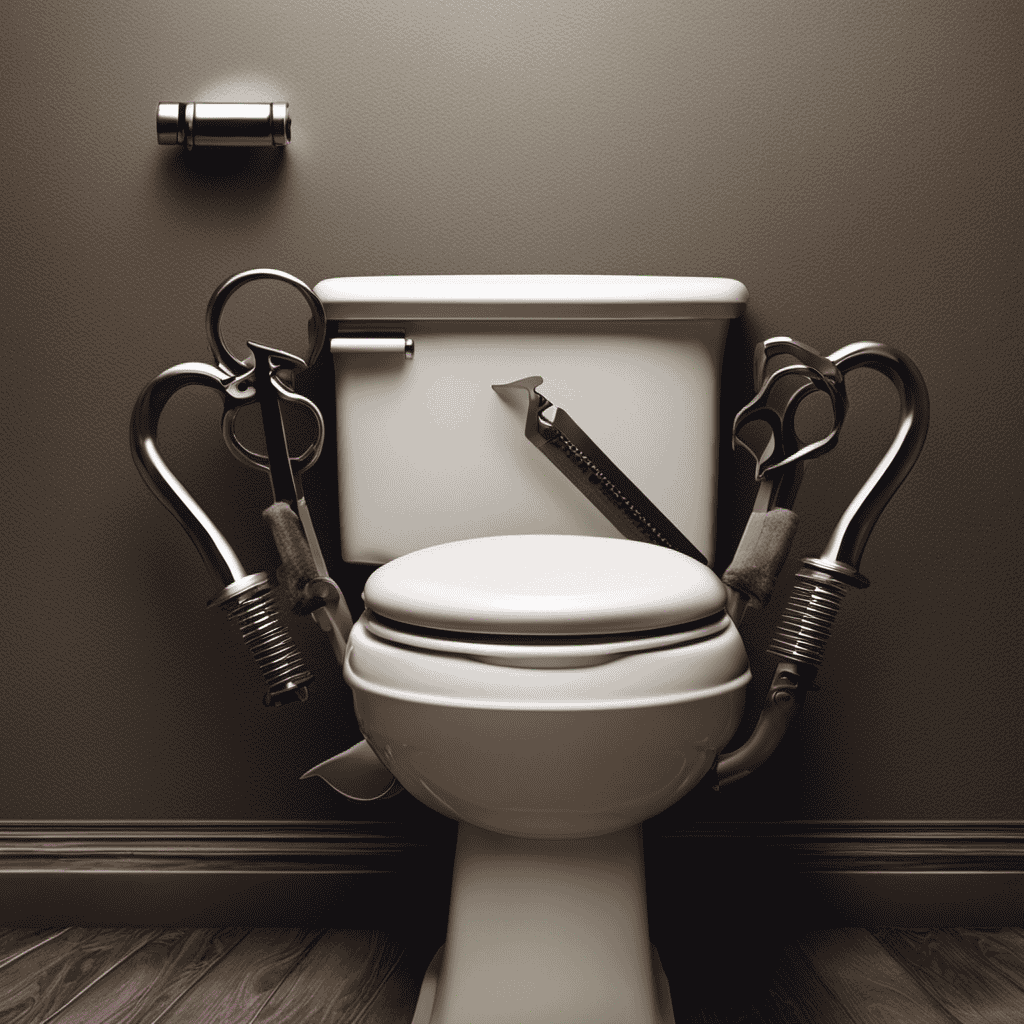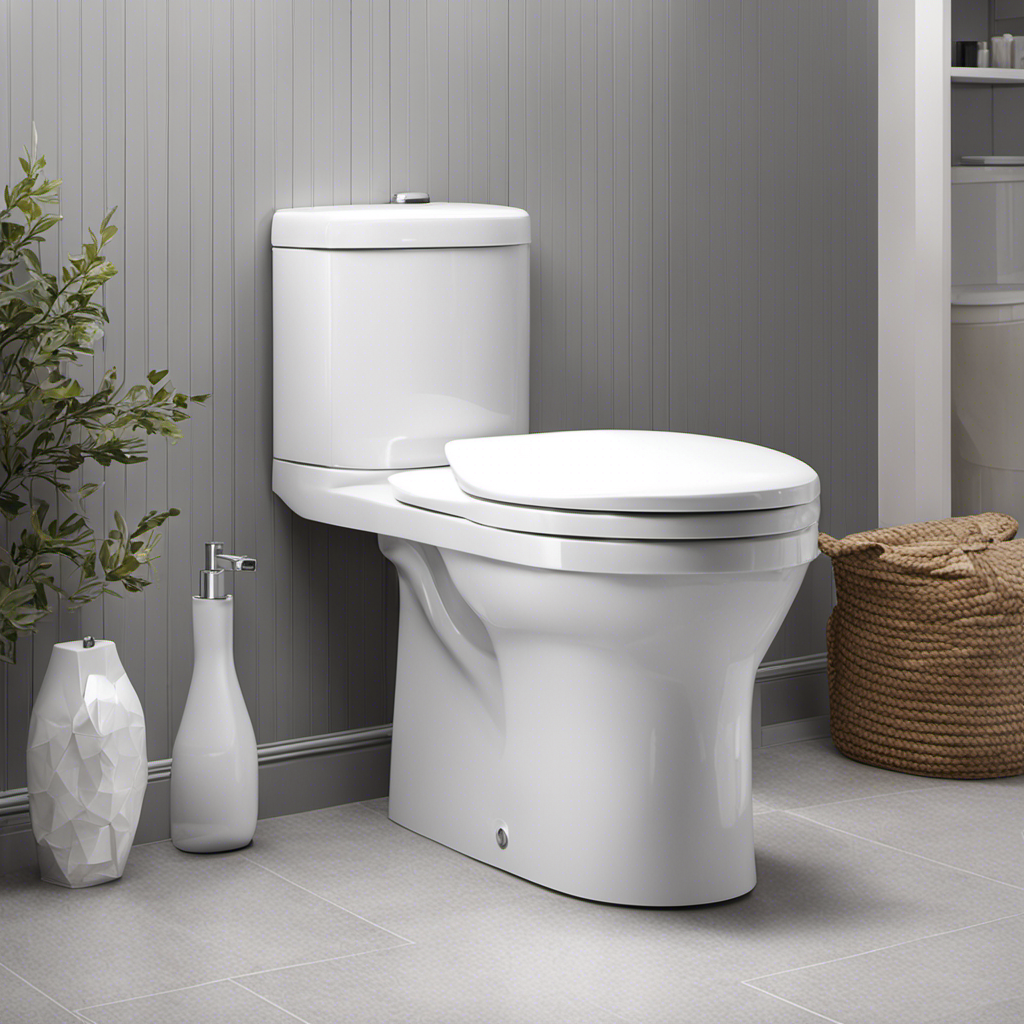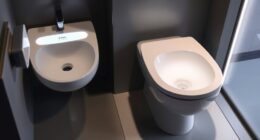Did you know that over 75% of households have encountered the need to remove toilet seat bolts at some point? If you’re facing this task, fear not! I’m here to guide you through the process step by step.
In this article, I will show you how to remove toilet seat bolts like a pro. With the right tools and a little know-how, you’ll have those stubborn bolts loosened and your toilet seat off in no time.
Let’s get started!
Key Takeaways
- Having the right tools, such as a screwdriver, adjustable wrench, and pliers, is essential for removing toilet seat bolts
- It is important to identify the type of bolts (wing nut or hex nut) in order to know how to remove and replace them
- Lubricants like WD-40 can be used to loosen stubborn bolts, and a hacksaw or bolt extractor tool may be needed in certain situations
- Proper cleaning, alignment, and tightening of the bolts ensure a secure, comfortable, and hygienic toilet seat.
Tools Needed for Removing Toilet Seat Bolts
To remove toilet seat bolts, you’ll need a few tools. The process of toilet seat removal and installation requires the use of a screwdriver, adjustable wrench, and possibly pliers.
The screwdriver is essential for loosening and removing the bolts that secure the toilet seat to the bowl. An adjustable wrench is useful for holding the nuts in place while you unscrew the bolts. Pliers may be necessary if the bolts are corroded or stubbornly stuck.
It’s important to have these tools on hand before attempting to remove the toilet seat bolts to ensure a smooth and efficient process.
Now that we have the necessary tools, let’s move on to step 1: identifying the type of toilet seat bolts.
Step 1: Identifying the Type of Toilet Seat Bolts
First, you’ll want to take a closer look at the type of bolts holding your toilet seat in place. Identifying the type of bolts is crucial for successful toilet seat installation or replacement.
There are typically two types of bolts used: wing nut bolts and hex nut bolts. Wing nut bolts have a wing-shaped nut that allows for easy tightening and loosening by hand. Hex nut bolts, on the other hand, require the use of a wrench or pliers to tighten or loosen them.
To determine the type of bolts, simply lift the seat cover and inspect the nuts securing the bolts. Once you’ve identified the type of bolts, you’ll be better prepared to remove them and proceed with the rest of the toilet seat removal process.
Step 2: Preparing the Area Before Removing the Bolts
Before diving into the process of removing toilet seat bolts, it is important to take certain safety precautions to avoid any accidents or injuries.
Firstly, make sure to wear protective gloves to protect your hands from any sharp edges or debris.
Additionally, ensure that the area around the toilet is clear of any obstacles to provide sufficient space for maneuvering and prevent any tripping hazards.
Lastly, gather the necessary tools for the removal process, such as an adjustable wrench or pliers, a screwdriver, and possibly a hacksaw if the bolts are rusted or stuck.
Safety Precautions for Removal
Make sure you’re wearing gloves and safety glasses when removing the toilet seat bolts. Safety should always be the top priority when working with tools and equipment.
Here are some key safety precautions to keep in mind during the toilet seat bolt removal process:
- Protect your hands with gloves to avoid any potential injuries or cuts.
- Wear safety glasses to shield your eyes from any debris that may fly off during the removal.
- Make sure the area around the toilet is clear of any obstacles to prevent accidents or tripping hazards.
By following these safety measures, you can ensure a smooth and accident-free toilet seat bolt removal process.
Now let’s move on to the next section to learn about the tools needed for the job.
Tools Needed for Removal
To remove the toilet seat, you’ll need a pair of pliers, a screwdriver, and an adjustable wrench. These tools are essential for a smooth and efficient removal process.
The pliers will help you grip and twist the bolts, while the screwdriver will be used to remove any screws or caps securing the seat. The adjustable wrench is necessary for loosening and tightening the nuts that hold the seat in place.
Having these tools on hand will make the task easier and ensure that you don’t damage any part of the toilet during the removal process.
Step 3: Removing the Nuts From the Toilet Seat Bolts
When it comes to removing toilet seat bolts, there are alternative methods that can be used if the traditional methods are not working.
One common alternative method is using a lubricant, such as WD-40, to loosen the nuts.
Another option is to use a hacksaw to carefully cut through the bolts.
However, it’s important to be aware of the common challenges that may arise during the removal process, such as rusted or stuck bolts, which can make the task more difficult.
Alternative Removal Methods
There’s an alternative method you can try to remove toilet seat bolts. If you’re dealing with stubborn bolts that just won’t budge, here are a few other methods you can attempt:
-
Use penetrating oil: Spray some penetrating oil, like WD-40, onto the bolts and let it sit for a few minutes. This can help loosen the rust or corrosion that may be causing the bolts to stick.
-
Apply heat: Heat can also help loosen stubborn bolts. Use a hairdryer or a heat gun to warm up the bolts, then try removing them while they’re still warm. Be careful not to overheat the bolts or surrounding areas.
-
Use a bolt extractor: If all else fails, a bolt extractor tool can come to the rescue. These tools are specifically designed to grip onto rounded or stripped bolts, making them easier to remove.
Common Challenges Faced
If you’re facing common challenges when removing toilet seat bolts, it’s important to stay patient and try alternative methods.
One common challenge is encountering rusted or corroded bolts. In this case, applying a penetrating oil can help loosen the bolts.
Another challenge is stripped bolt heads, which can make it difficult to use a wrench or screwdriver. To overcome this, you can try using pliers or a pair of vice grips to grip the bolt and turn it counterclockwise.
Additionally, tight or stubborn bolts can be challenging. To tackle this, you can use a breaker bar or a longer wrench for more leverage. Remember to apply steady, even pressure when turning the bolts.
Step 4: Detaching the Toilet Seat From the Bowl
To detach the toilet seat from the bowl, start by unscrewing the bolts using a wrench. This is a crucial step in removing the toilet seat safely and effectively. However, sometimes the bolts may become stubborn or difficult to loosen. In such cases, there are alternative removal methods and troubleshooting tips that can come in handy:
-
Apply lubricant: Spray a lubricant like WD-40 on the bolts to loosen them up and make them easier to unscrew.
-
Use pliers or vice grips: If the bolts are stuck, you can try using pliers or vice grips to grasp the bolt head and provide more leverage while unscrewing.
-
Apply heat: In extreme cases, where the bolts are rusted or severely stuck, you can try using a heat gun or hairdryer to apply heat to the bolts. This can help break down any corrosion and make them easier to remove.
Step 5: Cleaning and Replacing the Toilet Seat Bolts
Start by cleaning the area around the bolt holes using a mild cleaner and a cloth. This step is crucial to ensure a clean and secure reattachment of the toilet seat.
Take the time to carefully remove any dirt, grime, or residue that may have accumulated around the bolt holes. Use a cloth soaked in a mild cleaner to wipe away any debris and then dry the area thoroughly.
Once the cleaning process is complete, you can proceed with reattaching the toilet seat. Make sure to align the bolt holes on the seat with the holes on the bowl and insert the bolts. Tighten them securely using a wrench or a screwdriver.
A clean and properly attached toilet seat not only enhances the overall appearance of your bathroom but also provides a comfortable and sanitary experience.
Frequently Asked Questions
Can I Use a Regular Wrench to Remove Toilet Seat Bolts?
Yes, you can use a regular wrench to remove toilet seat bolts, but a toilet seat wrench is a specialized tool that makes the job easier and reduces the risk of damaging the toilet or scratching the seat.
Can I Remove the Toilet Seat Bolts Without Turning off the Water Supply?
No, you cannot remove toilet seat bolts without turning off the water supply. It is essential for toilet seat maintenance to ensure the water is off. There are alternative methods for removing the bolts, but safety is paramount.
How Do I Know if the Toilet Seat Bolts Are Rusty and Need to Be Replaced?
To determine if toilet seat bolts are rusty and need replacement, inspect them for signs of corrosion or discoloration. If they appear rusty, you can clean them with a rust remover and apply a protective coating to prevent future rusting.
Can I Reuse the Nuts That Were Removed From the Toilet Seat Bolts?
Yes, you can reuse the nuts from the toilet seat bolts, but there are pros and cons. It’s important to inspect them for any damage or rust. Alternatively, there are other methods for securing toilet seat bolts.
What Should I Do if the Toilet Seat Bolts Are Stuck and Cannot Be Removed?
If toilet seat bolts won’t budge, first try using a wrench or pliers to loosen them. If that doesn’t work, apply penetrating oil and let it sit for a few hours. Finally, use a hacksaw to carefully cut through the bolts.
Conclusion
Well, congratulations! You’ve successfully removed the toilet seat bolts and detached the seat from the bowl.
Now, all that’s left is cleaning and replacing the bolts. It’s a simple task, really. Just make sure to scrub away all those years of grime and replace the bolts with shiny new ones.
Ah, the joys of toilet maintenance! Who would have thought that removing toilet seat bolts could bring such satisfaction?
Now go forth and conquer the world, one toilet bolt at a time!










